U.S. MARINES SCORE VICTORY AT TARAWA
Tarawa, Gilbert Islands • November 23, 1943
On this date in 1943 the first U.S. offensive in the Central Pacific region was declared won after 76 hours of fierce fighting. The 4,800 Japanese defenders (soldiers, marines, and Japanese and Korean construction workers) on Tarawa Atoll in the Gilbert Islands were well-supplied and well-prepared, and they fought practically to the last man: just 17 enemy soldiers and 129 laborers were captured. The military importance of the small spits of enemy-held land lay in their strategic location at the gateway of the U.S. drive through the Central Pacific to the Marshall and Mariana Islands and beyond that to the Japanese Home Islands (see map). The effort, however, to retake the 12‑sq.‑mile/31‑sq.‑km coral atoll exacted a heavy toll on Marines of the U.S. 2nd Marine Division: more than one thousand leathernecks lost their lives and over twice that many were wounded. Four Marines were awarded Medals of Honor for valor. The U.S. Navy counted 687 dead—644 being the victims of a Japanese torpedo attack on the escort carrier Liscome Bay off Makin (pronounced “Muckin” or “Muggin”) Atoll, the northernmost of the Gilbert Islands. Sixty-six men of the U.S. Army’s 27th Infantry Division perished clearing Makin Atoll.
A parrot-shaped islet in the extreme southwest of the Tarawa Atoll, Betio was the main stage of the Battle of Tarawa (November 20–23, 1943). Besides being Tarawa’s main port with a long pier extending into the lagoon, Betio possessed an airstrip, which U.S. bombers had twice attacked, in April and September, inflicting severe damage on the installation. Thus, between April and the Marines’ amphibious assault on Betio on November 20, the Japanese had had months to string barbed wire across the exposed coral reefs about 800 yards/732 meters off shore, prepare a labyrinth of interconnecting coconut log and sand tunnels, and blanket practically every square yard/meter of Betio in tripwire mines, concealed rifle and machine-gun nests, artillery emplacements, concrete pillboxes, and a 10‑ft./3‑m‑high ventilated concrete blockhouse capable of accommodating 150 enemy defenders who could stymie the invaders’ advance into the interior. As night fell on the first day, the initial wave of Marines was confined to a thin strip of beach.
From Day 2 onward the assault Marines were reinforced in number, artillery, flamethrowers, and M4 Sherman tanks as they pushed off their deadly beachheads for Betio’s interior. Flushing out and shooting the defenders of one enemy redoubt after another allowed the Marines to roll up Japanese positions until all resistance had ceased on November 23, 1943. The so-called “Pocket” between Red Beaches 1 and 2, with 75 mm dual-purpose (surface and air) guns, was the last position of organized resistance to fall. Six thousand decomposing bodies of U.S. and Japanese servicemen, reeking an awful stench in the sweltering 110°F/43°C heat, every orifice of theirs covered in thick mats of black flies, were placed in unmarked common graves and covered with sand by a Navy Seabee bulldozer. The dead were part of the 541 Marines whose bodies were never recovered, some probably buried under an airstrip hastily built for the next assault on the next island chain lining up with the Japanese homeland.
Battle of Tarawa in the Gilbert Islands, November 20–23, 1943
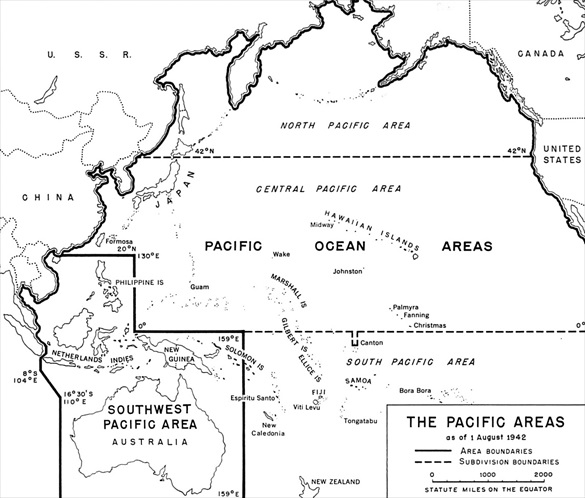 |
Above: Pacific Theater Command Areas, August 1942. Clockwise from top: North Pacific and Central Pacific (under Adm. Chester Nimitz), South Pacific (under Vice Adm. Robert Ghormley, who was succeeded by Adm. William Halsey, Jr. in mid-October 1942), and Southwest Pacific (under Gen. Douglas MacArthur). The North, Central, and South Pacific theater commands were subordinate commands of Pacific Ocean Areas under Adm. Nimitz throughout the war. Tarawa Atoll’s Betio Islet at 0.59 sq. mile/1.5 sq. km—half the size of New York City’s Central Park—and the Gilbert Islands straddle the dashed lines dividing the Central Pacific and South Pacific areas. Tarawa is located roughly 2,400 miles/3,862 km southwest of the Hawaiian Islands.
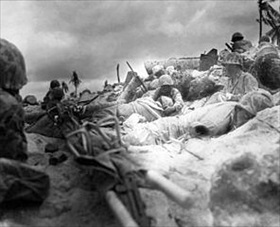 | 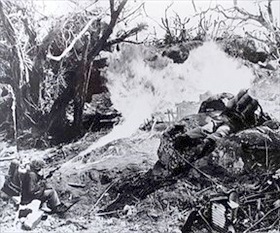 |
Left: Wading slowly through neck- and waist-deep water under withering enemy fire, Marine riflemen take cover among their dead and wounded behind a low sea wall on Red Beach 3, Betio Islet, November 1943. (There were 6 Betio invasion beaches.) The large bombproof concrete bunker and the sand-covered redoubt were within sight of Red Beach 3. The Battle of Tarawa was the first American offensive in this critical Pacific region, and it was also the first time in the war that the U.S. faced serious Japanese opposition to an amphibious landing. The commander of the Japanese garrison called Betio an impregnable fortress, which thankfully turned out to be a hollow boast. But Betio was also not a “piece of cake” that Marines were told about in preinvasion briefings.
![]()
Right: A Marine from 1st Marine Division uses a flamethrower to clear a path through what was once a thick jungle on Betio, November 1943.
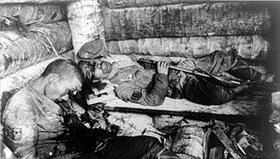 | 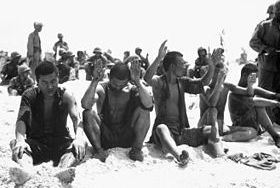 |
Left: Two marines of the Japanese navy’s Special Naval Landing Forces committed suicide in their dugout by shooting themselves rather than surrendering—for Japanese, the ultimate disgrace—to U.S. Marines, Betio, November 1943. Elsewhere Japanese dead lay in heaps in the sand after the 3½‑day slugfest on Betio had subsided. The enemy’s willingness to fight to the last man was an awful omen of the ferocity and countless deaths in island fighting to come.
![]()
Right: Field-stripped after their capture by U.S. Marines, these POWs, possibly Korean construction workers enslaved by the Japanese, sit on a Tarawa beach in rags and bare feet, November 1943.
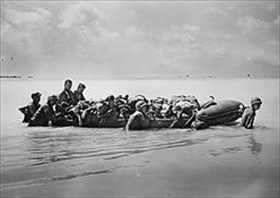 | 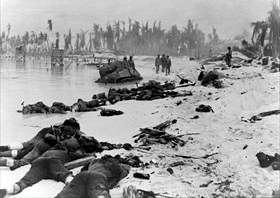 |
Left: Wounded Marines are floated for hundreds and hundreds of yards/meters over razor-sharp coral to waiting transports for eventual shipboard treatment, Betio, Tarawa Atoll, November 1943.
![]()
Right: Macabre photograph of dead Marines cut down by volleys of concentrated automatic weapons fire, Betio, Tarawa beach, November 1943. In the middle ground is a disabled 23‑ft./7‑m-long amtrac (officially LVT, or landing vehicle, tracked), which the Japanese had never seen before. The shoreline shows the devastating effects of both 1‑ton shellfire hurled from battleships and heavy cruisers and tons of bombs launched from U.S. Navy dive and torpedo bombers on the morning of the invasion. Indeed, the preinvasion bombardment had to be halted for 30 minutes to allow the flames, smoke, and dust to dissipate. Assaulting Marines were stunned that the enemy had survived the morning hellhole.
Marines at Battle of Tarawa, U.S. Government Color Film (1943)
![]()

 History buffs, there is good news! The Daily Chronicles of World War II is now available as an ebook for $4.99 on Amazon.com. Containing a year’s worth of dated entries from this website, the ebook brings the story of this tumultuous era to life in a compelling, authoritative, and succinct manner. Featuring inventive navigation aids, the ebook enables readers to instantly move forward or backward by month and date to different dated entries. Simple and elegant! Click
History buffs, there is good news! The Daily Chronicles of World War II is now available as an ebook for $4.99 on Amazon.com. Containing a year’s worth of dated entries from this website, the ebook brings the story of this tumultuous era to life in a compelling, authoritative, and succinct manner. Featuring inventive navigation aids, the ebook enables readers to instantly move forward or backward by month and date to different dated entries. Simple and elegant! Click 











